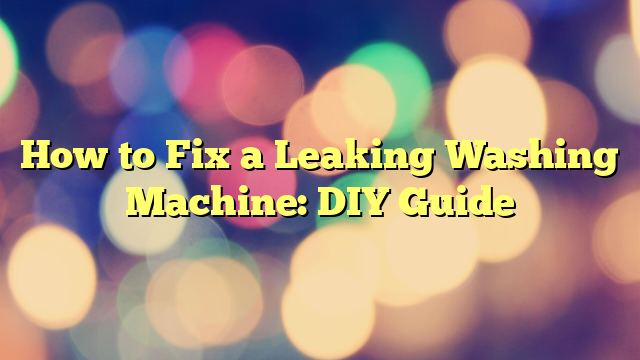Is your washing machine acting like a rogue sprinkler, leaving puddles of laundry woe in its wake? Don’t despair. With a little troubleshooting, you can become a leak-battling warrior before you call in the repair cavalry.
Common Leak Locations
Like a detective on the case, the first step is identifying the leak’s origin. Here are the usual suspects to investigate:
1. The Drainage Ditch:
The drain hose, that unsung hero responsible for whisking away soapy water, can develop leaks over time. Check for cracks, loose connections, or a kink hindering the flow.
2. The H2O Highway
The supply hoses, which deliver fresh water to your washer, can also be culprits. Inspect them for signs of wear, bulging, or cracks. Loose connections at the tap or the washing machine itself can also be a source of leaks.
3. The Gasket Guard (Front-Load Washers Only)
This rubber ring forms a watertight seal around the front door. Examine it for tears, mold, or debris that might compromise its integrity.
4. The Dispersal Deluge
While less common, the detergent dispenser drawer can also leak if clogged or damaged. Check for blockages and ensure it’s properly seated in its designated spot.
Inspect for Visual Signs of Damage
Once you’ve identified the potential culprits, grab your magnifying glass (figuratively speaking) and get ready to inspect! Look for any of these telltale signs:
- Visible cracks or tears in hoses or the door gasket.
- Bulging or loose hoses.
- Mold or mildew growing on the gasket (especially for front-loaders).
- Water pooling around the base of the machine or near the hoses.
Troubleshooting Guide and Solutions
Dealing with a leaking washing machine can be frustrating and potentially damaging to your home. However, understanding the source of the leak is the first step towards resolving the issue. In this comprehensive guide, we’ll help you identify the leak source and provide practical solutions to fix it, ensuring a hassle-free laundry experience.
1. Loose or Faulty Hoses
Tighten hose connections: First, check all the connections to ensure they are secured to the washing machine and water supply. Then, use a wrench to tighten any loose connections.
Replace worn or cracked hoses: Inspect hoses for signs of wear, such as cracks or bulges. If any hoses appear damaged, replace them with new ones to prevent leaks.
2. Door Gasket (Front-load washer)
Check for debris: Examine the door gasket for any debris or foreign objects caught in the seal. Remove any obstructions to ensure a proper seal.
Clean and mold removal:
- Clean the door gasket using water and mild detergent for minor issues.
- Use a soft brush to remove any mold or residue buildup.
- Consider using a specialized mold removal product for stubborn mold.
Replace damaged gasket: If the door gasket is damaged or worn, it may need to be replaced. Consult your washer’s manual for instructions on replacing the door gasket, or seek professional assistance.
3. Dispenser Drawer:
Clean clogged dispenser: Remove the drawer and clean it thoroughly to remove any detergent buildup or clogs. Use an appropriate cleaning solution and a brush to scrub away residue.
Inspect for damage: Check the dispenser drawer for any cracks or damage. If you find any damage to the dispenser, replace it with a new one to prevent leaks.
4. Other Potential Causes:
Oversudsing: Using too much detergent can result in overdosing, which can lead to leaks. Follow the manufacturer’s recommendations for detergent usage and use the correct amount for your load size.
Unbalanced load: Unevenly distributed laundry can cause the washing machine to become unbalanced during the spin cycle, resulting in leaks. Ensure the load is evenly distributed inside the drum before starting the wash cycle.
Safety First: Essential Precautions for Leak-Taming
Power Down: Always unplug your washing machine from the power outlet before starting any repairs. This eliminates the risk of electrical shock.
Water Woes: Turn off the water supply hoses connected to your washing machine. This prevents additional water from entering the machine and causing further damage.
The Right Tools: Use appropriate tools for the job. Standard tools you might need include wrenches for hose connections, screwdrivers for disassembly, and a level for checking alignment.
Ventilation is Key: Work in a well-ventilated area, especially if using any cleaning solutions or encountering mold.
People Also Read: How to Fix Leaking Whirlpool Washer
Top-Load Washer Leaks: Causes and Quick Fixes
Leakage in a top-loading washer can disrupt your laundry routine, but understanding the underlying causes and simple solutions can help you tackle the issue swiftly. Here, we explore common reasons for leaks and provide effective fixes to restore your washer’s functionality.
Leak at the Front of the Washer
- Clogged Overflow Tube:
Cause: Buildup of detergent residues, especially from overuse or incompatible products.
Solution:
- Conduct a simple test by soaking a washed item in water.
- If it turns soapy, reduce detergent usage.
- Consider switching to high-efficiency (HE) detergents that require less per wash.
2. Overloaded Washer:
Cause: Filling the washer beyond its recommended capacity, leading to leaks.
Solution: Adhere strictly to the recommended fill line and avoid overloading. To prevent overfilling, opt for smaller laundry batches or more frequent wash cycles.
3. Unlevel Washer:
Cause: Uneven placement, causing imbalance and subsequent leakage.
Solution: Ensure the washer sits at a level on the ground. Safely adjust the machine’s feet by lifting it with at least two people and unplugging it before making adjustments.
Leaks at the Back of Your Washer: Causes and Solutions
1. The hose Isn’t Connected to the Drain Pipe:
Cause: Improperly secured drain hose connection to the drainpipe.
Solution:
- Inspect the connection at the back of the washer.
- To prevent leaks, drain the hose into the entire drainpipe and secure the connection as needed.
2. Drain Pipe is Clogged:
Cause: Blockage in the drain pipe, leading to leaks despite a secure hose connection.
Solution: Clear the clog using methods similar to unclogging a sink, such as drain cleaners or snaking the drain pipe. For stubborn clogs, seek assistance from a service professional with power augers or specialized tools.
3. Fill Hoses Aren’t Properly Secured:
Cause: Cracked or brittle fill hoses that lead to leaks.
Solution:
- Regularly inspect fill hoses for signs of wear or damage.
- Replace any worn-out hoses promptly to prevent leaks.
- Ensure new hoses are securely connected to the washer and water supply.
4. Rubber Washers Are in Poor Condition:
Cause: Deterioration of rubber washers over time, resulting in leaks.
Solution: Remove the hose and inspect the rubber washers for deterioration. Replace them with new washers and secure them correctly to prevent leaks.
Leaks Under Your Top-Load Washer: Causes and Solutions
- Water Pump Leak:
Cause: A malfunctioning water pump, which is responsible for circulating water within the machine, leads to leaks from the bottom.
Solution: If you observe leakage, promptly replace the water pump. While some adept individuals may attempt replacement themselves, it’s recommended to seek assistance from a professional, such as a Mr. Appliance® service expert, for accurate diagnosis and repair.
- Tub Defect:
Cause: Cracks or defects in the outer tub of the washing machine can result in leakage.
Solution: If a defect is identified, contact a professional to assess and replace the tub. Professional expertise ensures proper diagnosis and repair to address the issue effectively.
- Malfunctioning Water Level Switch:
Cause: Dysfunction of the water level switch or sensor, leading to improper water filling and potential overfilling.
Solution: Replacement of the water level switch requires specialized tools and expertise. Contact your local Mr. Appliance for professional repair service to ensure accurate diagnosis and effective resolution.
Front-Load Washer Leaks: Causes and Solutions
1. Leak at the Front of the Washer:
1. Door Gasket Issues:
Cause: Improper door gasket sealing due to deterioration or detergent buildup.
Solution:
- Regularly clean the gasket to prevent product buildup and mold.
- Switch to dryer sheets or wool dryer balls instead of liquid fabric softener.
- If the issue persists, consider replacing the gasket with the help of professionals.
2. Misaligned Door:
Cause: Misalignment or improper latching of the door leading to water leakage.
Solution: Adjust the hinges by loosening and retightening them.
Leak at the Back of the Washer
Causes: Similar to top-load washers, issues such as a clogged drain pipe, poor connection of pipes or hoses, worn-out rubber washers, or damage to fill hoses can cause leaks.
Solution: Ensure proper installation and maintenance of pipes, hoses, and rubber washers. Address detergent buildup and excessive suds by using a smaller amount and switching to HE detergent if applicable.
Leak Under the Washer:
Causes: Water pump malfunctions and detergent-related issues can cause leaks under the washer.
Solution: After a professional assessment, consider replacing the water pump. Avoid the hassle of shopping for a new machine by opting for repair services, which are often more cost-effective and convenient.
Related Topics:
FAQ About a Washing Machine Leaking Water
Is It Worth Fixing a Leaking Washing Machine?
Yes, it is worth fixing a leaking washing machine. Most issues can be resolved through simple adjustments or repairs. Professional assessment by a service professional can also provide solutions to ensure your washer functions appropriately.
Why Has My Washing Machine Flooded My Floor?
Various factors can cause a washing machine to flood the floor, so it’s crucial to determine the source of the leak. Potential causes include excessive detergent, clogged tubing, an unbalanced machine, or issues with the gasket’s sealing.
Can a Washer Leak If Overloaded?
Yes, overloading the washing machine can cause leaks. Overfilling the machine exceeds its capacity, leading to water overflow during the wash cycle. To prevent leaks, it’s essential to follow the manufacturer’s recommendations regarding load size.
How Can I Identify the Source of the Leak in My Washing Machine?
Start by observing where the water is pooling or dripping from. Check common areas such as hoses, seals, and connections for any signs of damage or looseness. Inspecting can help pinpoint the exact source of the leak.
What Should I Do If I Notice Water Leakage from My Washing Machine?
If you detect water leakage, immediately turn off the machine to prevent further damage. Clean up any spilled water and inspect the washer for visible signs of the leak’s origin. Depending on the severity and cause of the leak, consider performing simple troubleshooting steps or seeking professional assistance.
Can Using the wrong detergent cause my washing machine to leak?
Yes, using the wrong detergent or too much detergent can contribute to washing machine leaks. Certain detergents may create excessive suds, leading to overflow and leakage. To prevent such issues, it’s essential to use the appropriate detergent type and amount recommended by the manufacturer.
How Often Should I Inspect My Washing Machine for Potential Leaks?
Regular inspection of your washing machine is crucial for promptly identifying and addressing any potential leaks. Consider conducting visual checks of hoses, seals, and connections every few months.
What Are Some Preventive Measures to Avoid Washing Machine Leaks?
To minimize the risk of leaks:
1. Ensure proper installation of the washing machine, including securing hoses and connections.
2. Follow recommended maintenance guidelines, such as cleaning the detergent dispenser and inspecting seals regularly.
3. Avoid overloading the machine and use the correct detergent amount to prevent excessive sudsing.


